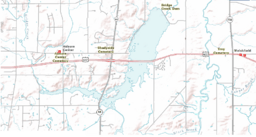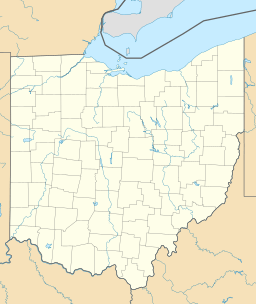LaDue Reservoir facts for kids
Quick facts for kids LaDue Reservoir |
|
|---|---|

USGS Map of LaDue Reservoir
|
|
| Location | Auburn Twp and Troy Township, Geauga County, Ohio |
| Coordinates | 41°23′19″N 81°11′50″W / 41.38861°N 81.19722°W |
| Type | reservoir |
| Primary inflows | Bridge Creek and Black Brook |
| Primary outflows | Bridge Creek and Black Brook |
| Catchment area | 42 sq mi (110 km2) |
| Basin countries | United States |
| Max. length | 5.5 mi (8.9 km) |
| Max. width | .15 to .8 mi (0.24 to 1.29 km) |
| Surface area | 1,477 acres (5.98 km2) |
| Max. depth | 21 ft (6.4 m) |
| Water volume | 18,100 acre⋅ft (22.3 hm3) |
| Shore length1 | 24.3 mi (39.1 km) |
| Surface elevation | 1,127 ft (344 m) |
| 1 Shore length is not a well-defined measure. | |
LaDue Reservoir is a large, man-made lake located in Geauga County, Ohio. You can find it near Ohio State Route 44 and U.S. Route 422 in Auburn and Troy Townships.
This reservoir was originally called the "Akron City Reservoir." It was renamed LaDue Reservoir on October 11, 1961. The new name honored Wendell R. LaDue. Other names for the reservoir have included Bridge Creek Reservoir and Wendell R. Ladue Reservoir.
LaDue Reservoir was formed by building two dams. The Bridge Creek Dam crosses Bridge Creek. The Black Brook Dike crosses Black Brook. Both of these creeks flow into the Cuyahoga River.
The area where the reservoir sits was once covered by a huge sheet of ice. This happened during the Wisconsinan glaciation (a very old ice age). Because of this, the area has many natural sand and gravel hills called kames. It also has small ponds called kettles. The bottom of the lake still looks like it did before the dams were built.
Contents
Why Was LaDue Reservoir Built?
The City of Akron, Ohio owns the reservoir and the land around it. Akron's Watershed Division manages the reservoir.
LaDue Reservoir is one of three important reservoirs that supply water to the City of Akron. The others are East Branch Reservoir and Lake Rockwell. These reservoirs have several key jobs.
- They help control floods in areas downstream.
- They keep the river flowing well during dry times.
- They make sure Akron has enough clean drinking water.
Lake Rockwell is Akron's main source of drinking water. Because of this, it is very protected. You cannot trespass, fish, or do other activities there. However, LaDue Reservoir and East Branch Reservoir are open for fishing, boating, and hunting.
There are special rules for LaDue Reservoir. For example, you cannot use gasoline motors on boats. Electric motors have size limits. Also, you can only fish from the shoreline in certain areas. These areas are along Ohio State Route 44, U.S. Route 422, and Auburn Road.
Understanding the Dams at LaDue Reservoir
Two main structures create LaDue Reservoir: the Bridge Creek Dam and the Black Brook Dike and Dam. These structures are important for holding back water.
Bridge Creek Dam: The Main Structure
The Bridge Creek Dam is also known as the LaDue Dam. It is made of rolled earth with a special core that stops water from leaking.
- It is about 35 feet (11 meters) tall.
- The top of the dam is 3,200 feet (975 meters) long.
- The top is 40 feet (12 meters) wide, and the base is about 120 feet (37 meters) wide.
- There is a spillway, which is a channel for extra water to flow out safely. This spillway is 200 feet (61 meters) wide at the top.
The Bridge Creek Dam area is a restricted zone. This means you are not allowed to enter it. There are signs on land and marker buoys in the water to show this.
Black Brook Dike and Dam: Supporting Structures
The Black Brook Dike is a long, wide wall. It is about 100 feet (30 meters) wide and nearly 1 mile (1.6 km) long. You can find it at the southern end of the reservoir.
The Black Brook Dam is also made of rolled earth. It has a core to prevent leaks.
- It is about 20 feet (6 meters) tall.
- The top is 325 feet (99 meters) long and 30 feet (9 meters) wide.
- It uses a 6-foot (1.8-meter) concrete ditch to let water out.
Like the Bridge Creek Dam, the Black Brook Dike and Dam are restricted zones. Please respect the "No Trespassing" signs and marker buoys.
Fun Activities at LaDue Reservoir
The LaDue Reservoir wildlife area is a large natural space. It covers about 8,791 acres (3,557 hectares). This area helps protect the water that flows into the east branch of the Cuyahoga River.
The Ohio Department of Natural Resources (ODNR) manages many activities here. Since 2002, their Division of Wildlife has overseen the LaDue Public Hunting Area. This includes hunting, trapping, boating, and fishing.
The wildlife area is home to many different animals. You might see white-tailed deer, wild turkey, squirrels, rabbits, and woodchucks. Many types of waterfowl also visit, such as mallards, wood ducks, and Canada geese.
LaDue Reservoir is also a great place for fishing. You can catch fish like walleye, largemouth bass, bluegill, yellow perch, white and black crappie, and channel catfish.
Boating and Fishing Rules
There are special rules for boating and fishing at LaDue Reservoir. These rules are set by the Ohio Revised Code.
- Only electric motors are allowed on boats. Gasoline engines are not permitted.
- You can only fish from the shoreline in specific areas. These are along Ohio State Route 44, U.S. Route 422, and Auburn Road.
- To fish in Ohio, you need a valid Ohio Fishing License. You must also follow all Ohio fishing regulations.
The ODNR Division of Wildlife has a gravel boat ramp for easy access. It also has portable toilets. You can find this ramp near the intersection of East Washington Street and Valley Road. There is another boat ramp at the south end of the reservoir where Ohio State Route 44 crosses.
Since 2019, you can rent kayaks and fishing boats from the LaDue boathouse through Breakaway Excursions.
Hunting and Trapping Rules
If you want to hunt waterfowl at LaDue Reservoir, you must go to special areas. Hunters are chosen through a yearly drawing held by the ODNR Division of Wildlife. All hunting in Ohio must follow hunting regulations.
Trapping certain animals, like beaver or river otter, is also allowed. However, you need a special permit. Trappers are chosen through a yearly drawing by the Division of Wildlife. All trapping in Ohio must follow trapping regulations.
Understanding Environmental Conditions
In 2010, very hot weather caused concerns about harmful algal blooms in many lakes in Northeast Ohio, including LaDue Reservoir.
A harmful algal bloom happens when certain types of blue-green algae grow too much. These algae can produce toxins. Some toxins, called neurotoxins, can affect the nervous system. Others, called hepatotoxins, can harm the liver.
The Ohio Department of Health now monitors these blooms to keep people safe.


